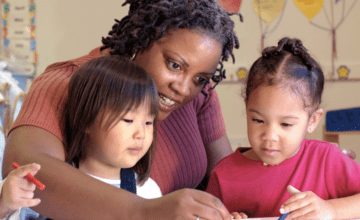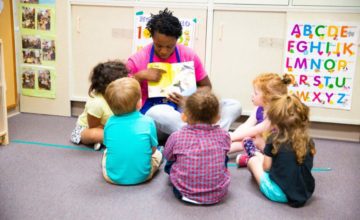Learn how to nurture your baby’s social emotional, intellectual, language, and motor development from 18 to 24 months. Explore more age ranges in our full Healthy Minds Series.
This handout is based on findings from a report From Neurons to Neighborhoods: The Science of Early Childhood Development* from the National Academy of Sciences that examined child and brain development in the early years. The information we offer is age-specific, summarizes key findings from the report, and suggests how you might be able to use these key findings to nurture your own child’s healthy development.
Key Findings
Findings from the From Neurons to Neighborhoods: The Science of Early Childhood Development include:
- Your relationship with your child is the foundation of his or her healthy development.
- Your child’s development depends on both the traits he or she was born with (nature), and what he or she experiences (nurture).
- All areas of development (social, emotional, intellectual, language and motor) are linked. Each depends on, and influences, the others.
- What children experience, including how their parents respond to them, shapes their development as they adapt to the world.
How Development Looks in Everyday Life
This shows how all areas of Alicia’s development are linked and how her father’s response encourages her healthy development.
Because of Alicia’s social and emotional connection to her father, he is the one she goes to for safety and comfort when she is feeling anxious. She knows that she can count on her father for support.
Relationships are the foundation of a child’s healthy development.
Her intellectual ability enables her to communicate her feelings by using her language skills—gestures, facial expressions and words. She uses her motor ability to pull on Dad to get him to take her home. Darryl’s response helps Alicia master a challenging situation. He is able to put aside his own interest in staying at the group and “listens” to what Alicia is trying to tell him. This allows him to help her feel more comfortable entering a new situation, now and in the future.
Charting Your Child’s Healthy Development
The following chart describes many of the things your baby is learning between 18 and 24 months and what you can do to support your child in all areas of her development. As you read, remember that children develop at their own pace and in their own way. Understanding who your child is, what her strengths are and where she needs more support, is essential for promoting her healthy development. If you have questions regarding your child’s development, ask your pediatrician.
| What’s going on: | What you can do: | Questions to ask yourself: |
|---|---|---|
| Toddlers’ vocabularies are growing by leaps and bounds. | Expand on what your child says. When she says, “Dolly fall!” you can say, “Yes, Dolly tumbled down to the floor!” This helps you expand your child’s language skills. | What are your child’s strengths in communicating? Where does she need help? |
| Toddlers are learning and saying many new words, and stringing words together, such as “Dolly fall.” Toddlers are very independent and eager to be in control. Among their favorite words are “Me” and “Mine!” | Give your toddler ways to feel in control by giving choices among options that are all acceptable. Let her choose between the red or blue cup and the pink or green shirt. Avoid asking her opinions when only one option is okay; for example, do not ask, “Are you ready to go?” unless she can stay longer. Use language to help her predict what will happen. “In five minutes it will be time to go.” | How does your child express her thoughts and feelings? Is she more likely to use her words or actions? How do you respond? |
| Toddlers don’t yet understand the consequences of their actions. | Use consequences that are directly connected to the behavior of your child. If she is pouring water on her high chair after being told not to, take her out of her high chair. Then offer other acceptable options such as water play in the bathtub or outside. | How were you disciplined as a child? How do you think that influences how you discipline your child? |
| Toddlers are developing self-control, but they still cannot stop themselves from doing something unacceptable, even after many reminders. | Help prevent tantrums or loss of control by heading them off at the pass. If you see your child getting frustrated, try to calm her down and suggest another activity before she starts hurling puzzle pieces. Help your obviously angry toddler avoid a fight with her friend by inviting them to pause for a snack. | What behaviors do you find most difficult to handle? Why? |
| Toddlers are able to play and explore in more complex ways. They like toys that they can play with in many different ways such as blocks, cars and stuffed animals that lend themselves to imaginative play. | Provide your child with objects and toys that lend themselves to imaginative play and join in with them. You will learn a lot about her thoughts and feelings and can help her expand her thinking. Sand, water, play dough and drawing materials are all good choices for children this age. They help develop your child’s creativity and strengthen muscles that your toddler will use later in handwriting. | What are some of the ways your child uses pretend play? What does this tell you about her? |
| Toddlers love to move. In just a matter of months, children go from crawling to walking to practically running! Practicing their new moves strengthens the brain connections that help with coordination. Children learn a lot from active play. For example, they learn about gravity and up and down when they swing and go down the slide. | Turn a walk into a learning opportunity. Point out big and small dogs in the park. Talk about the colors of the cars on the street. This kind of learning makes new ideas and concepts stick. | What do you most/least enjoy about playing with your toddler? |
*About “From Neurons to Neighborhoods”
The report From Neurons to Neighborhoods: The Science of Early Childhood Development was a 22-year effort by a group of 17 leading professionals with backgrounds in neuroscience, psychology, child development, economics, education, pediatrics, psychiatry and public policy. They reviewed what was known about the nature of early child development and the influence of early experiences on children’s health and well-being. The study was sponsored by a number of federal agencies and private foundations.



